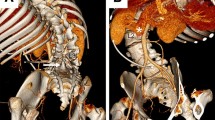Abstract
Introduction
Atlanto-axial rotatory fixation (AARF) is a rare complication of ventriculo-peritoneal shunt (VPS) surgery.
Case presentation
The authors present a unique case of AARF developing early after VP shunting, with persistent torticollis, a “cock-robin” head position, and a thick fibrous band along the catheter path. Due to refractoriness to conservative treatments, AARF, which can be an early-onset complication of VPS surgery, was resolved by removing the distal catheter along with the fibrous band encasing it.
Conclusion
Surgical removal of the fibrous band might be enough to solve such complication with no need of further surgical fusion procedures.



Similar content being viewed by others
References
Hashimoto M, Yokota A, Urasaki E, Tsujigami S, Shimono M (2004) A case of abdominal CSF pseudocyst associated with silicone allergy. Childs Nerv Syst 20(10):761–764
Heary R, Reid P, Carmel P (2011) Atlantoaxial rotatory fixation after ventriculoperitoneal shunting. Neuropediatrics 42:197–199
Hussain NS, Wang PP, James C, Carson BS, Avellino AM (2005) Distal ventriculoperitoneal shunt failure caused by silicone allergy. J Neurosurg 102(3):536–539
Ishii K, Toyama Y, Nakamura M, Chiba K, Matsumoto M (2012) Management of chronic atlantoaxial rotatory fixation. Spine (Phila Pa 1976) 37:E278–E285
Pang D, Li V (2004) Atlantoaxial rotatory fixation: part 1—biomechanics of normal rotation at the atlantoaxial joint in children. Neurosurgery 55:614–625
Pang D, Li V (2005) Atlantoaxial rotatory fixation: part 2—new diagnostic paradigm and a new classification based on motion analysis using computed tomographic imaging. Neurosurgery 57:941–953
Pang D, Li V (2005) Atlantoaxial rotatory fixation: part 3—a prospective study of the clinical manifestation, diagnosis, management, and outcome of children with atlantoaxial rotatory fixation. Neurosurgery 57:954–972
Singh G, Kaif M, Ojha BK, Chandra A, Cronk K, Nakaji P (2011) Torticollis as a late complication of ventriculoperitoneal shunt surgery. J Clin Neurosci 18(6):865–866
Author information
Authors and Affiliations
Corresponding author
Ethics declarations
Conflict of interest
The authors declare that they have no conflict of interest.
Informed consent
Informed consent was obtained from the patient and his parents.
Rights and permissions
About this article
Cite this article
Zattra, C., Schiariti, M.P., La Corte, E. et al. Atlanto-axial rotatory fixation complicating ventriculo-peritoneal shunt surgery: a case report and literature review. Childs Nerv Syst 35, 713–717 (2019). https://doi.org/10.1007/s00381-018-3983-7
Received:
Accepted:
Published:
Issue Date:
DOI: https://doi.org/10.1007/s00381-018-3983-7




